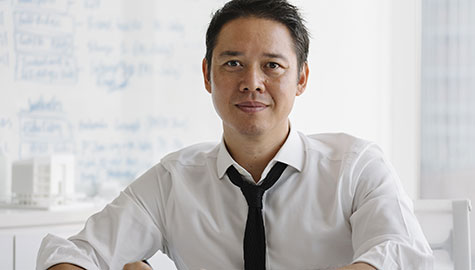
Smart and sustainable: designing the future.

What does it mean to literally build the future? Singapore-based architect, academic and author Professor Jason Pomeroy explains the essence behind sustainable design, the impact of responsible investment and why carbon-negative housing should be on your radar.
We all want to leave a legacy, whether it’s through our life’s work, the values we pass on to the next generation or the ideas we bring to life. Professor Jason Pomeroy, founding principal of Pomeroy Studios, TV presenter and thought leader in the field of sustainable architecture, is creating a unique legacy that will shape cityscapes and the experience of urban living around the world. Here, he shares why sustainable design matters, and what you need to know beyond the triple bottom line.
What should sustainable architecture achieve, environmentally and culturally? How should it affect the human experience?
Environmental and cultural conservation are dual pillars that are achieved through sustainable architecture but are just part of a far more complex bigger picture. The onslaught of climate change requires us to design by reducing, reusing, recycling and adding a fourth R — “re-energising” by embracing renewable energies — as a means of preserving the natural environment. It means we should design with the objective of using less natural resources and take inspiration from the past where our ancestors lived in harmony with nature, incorporating natural light and ventilation; using locally sourced materials and orientating buildings to greatly reduce energy and water consumption.
When it comes to culture, we need to take into consideration what defines a society or a community through historical events or traditional practices. Mass global consumerism has led to the eradication of long-held traditions and customs. Sustainable architecture has to ensure such traditions are preserved through the surroundings to add character and identity to the urban habitat. This is where conservation has a huge impact. At the end of the day, people should feel comfortable in their surroundings and be inspired to live better lives within their communities. These should be the primary objectives of sustainable design: creating a human experience that is environmentally and culturally sensitive.
How do you want the humans who live and work in the spaces you create to feel?
A sense of belonging. Our designs may look sleek, curvilinear, with an abundance of greenery. People may say, “That is a Pomeroy Studio design.” But a person living, working, playing or learning in one of our cities, buildings, landscapes or interiors should feel a certain cultural resonance with the place’s history and its people too.
I sincerely hope that people feel comfortable in the surroundings we have created — regardless of whether they have a penchant for the modern, eco-friendly aesthetic or the traditional, culturally reinterpretative aesthetic.
With more people interested in responsible investing, what do you think people should be cognisant of?
I believe that the triple bottom line of sustainability (the social, economic and environmental pillars) does not necessarily provide a balanced view of what one should consider when investing in real estate. This is why I believe that six parameters of sustainable development provide a more balanced view and offer a reasonable set of “prompts for thinking” for sustainable real estate investment. The additional three are spatial, cultural and technological sustainability.
Why? We’re living in a spatially constrained world where every inch counts. In a globalised world where cultural values and past traditions are being eroded, it is also time we ensure cultural sustainability in developments to remind ourselves of who we are and where we came from. And as we live in the digital age, we should similarly embrace technology wisely to ensure our lives and lifestyles can be enhanced.
Set alongside the economic mantra of “location, location, location” and proximity to good local transportation networks and the provision of education and healthcare, the environmental basics of passive design to ensure natural light and ventilation are optimised, and social considerations that can bring the community together through recreation, one should be on a good path for sustainable investments.
Pomeroy Studio’s pioneering carbon-negative B House has now been lived in — what learnings can you share?
That they really are the future. “Carbon negative” is a step beyond “carbon zero”. The B House development generated even more clean energy than what was being consumed — thus having a surplus of clean green energy and being “carbon negative”. The ability to look at real estate as an alternative source of energy generation that can not only self-sustain but generate surplus energy that may support the community is key to the future resilience of our districts and communities.
What makes you feel in your element in Singapore?
The ability to breathe clean air; to gaze on lush sky courts and sky gardens; to move seamlessly and with little delay using public transportation; and to know I am leaving a green legacy for future generations that embraces home-grown values.
What impact would you like to make during your years in this adopted home?
As an architect and master planner, I have designed sustainable developments from the macro scale of smart cities to the micro scale of zero-carbon homes.
As a professor, I have shared my research through books, periodicals and lectures. As a TV presenter I have brought the culture of cities and buildings into people’s living rooms.
As long as I have been able to touch someone’s life, whether a six-year-old child or a septuagenarian, by highlighting the importance of embracing the green agenda within the built environment in these cataclysmic times, I would feel that my job is done.

